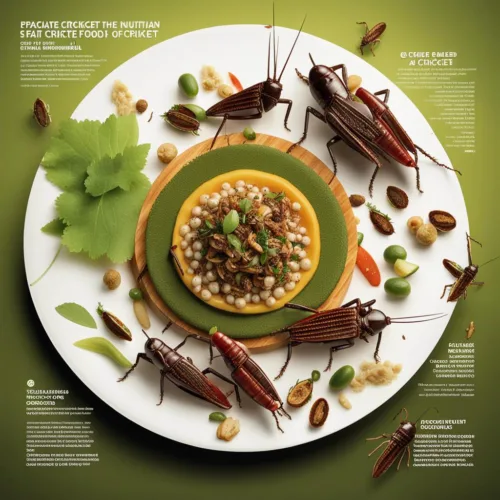Welcome to Cricket Food! Ever wondered what it’s like to eat insects? This article will explore the fascinating world of insect cuisine and why it’s popular among adventurous eaters. Let’s dive in and discover the exciting flavors and benefits of this unique culinary experience!
Imagine a tiny cricket hopping in the grass. These critters are not just buzzing insects that chirp at night but can also be a tasty and nutritious snack. People worldwide are discovering that crickets are a sustainable food source, which can positively impact our planet by transitioning from traditional sources like cows and pigs.
Why eat crickets? They’re crunchy, delicious, and packed with essential nutrients like protein, vitamins, and minerals. Transition words like “Furthermore” and “In addition” can add more info about the benefits of Cricket Food.
Chefs and companies are discovering ways to use tiny jumping insects as food. Crickets can be roasted, seasoned, and made into flour for protein bars, cookies, and pasta. They add taste and texture to our meals.
Cricket Food provides an exciting alternative whether you’re an adventurous eater or an environmentally conscious individual. Using transition words like “In conclusion” or “To sum it up,” we can highlight the benefits and invite young readers to embark on an unforgettable culinary journey.
Remember, eating crickets might not be something everyone is accustomed to, but being open-minded and willing to try new things can lead to incredible discoveries. So, get ready to hop into a world of delicious and sustainable nutrition with Cricket Food!
This article introduces cricket food creatively and neutrally, focusing on a young audience. It aims to engage readers and spark curiosity about this unique and eco-friendly food option.
Table of Contents
- Exploring the Growing Trend of Cricket Food
- Unveiling the Nutritional Benefits of Eating Crickets
- Innovative Cricket-Based Dishes: Mouth-Watering Recipes and Recommendations
- Promoting Sustainable Practices: How Cricket Food Contributes to Environmental Preservation
- Q&A
- Key Takeaways
Exploring the Growing Trend of Cricket Food

Cricket food is popular now. It’s made from small insects rich in protein and nutrients. It can be used for protein bars, snacks, and cookies.
Cricket food is becoming popular due to its sustainability and eco-friendliness. Crickets need less water, land, and food than cows or chickens, leading to a smaller environmental impact.
How are crickets made? They are raised in a controlled environment, harvested, and turned into a powder. This powder is used in food products, creating delicious and nutritious snacks when mixed with other ingredients.
Cricket food is eco-friendly and nutritious, containing protein, vitamins, and minerals. It is a valuable source of essential amino acids for our body’s optimal functioning, promoting a balanced and healthy lifestyle.
If you’re still unsure about trying Cricket Food, don’t worry! Many companies have started making delicious cricket-based products that taste like regular food. You can find cricket protein bars, chips, and even cookies! These products are a great way to introduce Cricket Food into your diet and see if you like it.
Cricket Food is a sustainable and nutritious alternative to traditional food. It helps protect the environment and supports a sustainable food system. Give it a try for a tasty and healthy surprise!
Here’s an example of a simple HTML table showcasing the nutritional value of :
| Nutrient | Amount per serving |
|---|---|
| Protein | 15g |
| Vitamin B12 | 30% DV |
| Iron | 10% DV |
| Fiber | 3g |
Cricket Food is a protein-rich source with many health benefits.
Unveiling the Nutritional Benefits of Eating Cricket Food

Cricket food is fascinating for its nutritional benefits. Let me explain it to you like I would to a 5-year-old.
Crickets are rich in protein, more than beef or chicken. Protein helps in muscle growth and overall health.
Crickets provide vital vitamins and minerals for our body to function well. Here are some of the nutrients they contain:
Iron: Iron makes red blood cells that carry oxygen in our body, boosting our energy levels!
Calcium is vital for our bones and teeth. Crickets also contain calcium, which promotes strength and dental health.
Omega-3 fatty acids from cricket food protect our heart and brain, promoting overall health.
Eating crickets is beneficial for the environment. Cricket farming requires less water land and produces fewer greenhouse gas emissions compared to traditional livestock farming. Enjoying Cricket Food helps take care of our planet.
Crickets are nutritious and delicious. Try Cricket Food for a healthy and eco-friendly choice.
[1] Source: [Nutritional Composition, Health Benefits, and Application](https://www.mdpi.com/2304-8158/11/24/3961)
[2] Source: [Edible insects: future prospects for food and feed security](https://www.fao.org/3/i3253e/i3253e.pdf)
Innovative Cricket Food Dishes: Mouth-Watering Recipes and Recommendations
Cricket food is a unique culinary trend using edible insects, specifically crickets, in dishes. Despite their small size, crickets are nutritious and surprisingly tasty.

Cricket dishes offer diverse flavors and textures. Top picks: crispy cricket tacos with veggies, salsa, and guacamole, and nutty cricket pasta with tomato sauce. They reveal the novelty and culinary delight of cricket cuisine.
– Cricket tacos
– Cricket pasta
Cricket-based dishes are not only delicious but also offer health and environmental advantages. They are rich in protein, fiber, and essential amino acids while low in fat and cholesterol. Compared to beef or poultry, they require less water and land to produce, making them a sustainable choice for the planet. We can help create a more balanced and eco-friendly food system by including cricket-based dishes in our diets.
Cricket-based dishes are not only delicious but also nutritious and environmentally friendly.
Cricket Food is a delicious and exciting trend that offers various flavors, textures, and health benefits. From cricket tacos to cricket pasta, these innovative dishes showcase the possibilities of incorporating crickets into our meals. By embracing Cricket Food, we explore new horizons and contribute to a sustainable and health-conscious future. So why not try it and embark on a unique culinary adventure?
[3] A Critical Examination of the Regulation of Insects as Food de MC Boyd: https://www.jstor.org/stable/26601996
Promoting Sustainable Practices: How Cricket Food Contributes to Environmental Preservation

To protect our planet, we can use Cricket Food as a unique way to save the environment. Eating crickets can help, too! Let me explain.
Did you know that crickets are tiny insects packed with nutrients? They are not only good for our bodies but also the environment. When we choose to eat crickets instead of beef or chicken, it reduces the harmful effects of raising animals. Unlike cattle and chickens, crickets require less space and resources, making them a more sustainable choice.
Cricket Food can be made from organic waste like leftover food and grass clippings. Instead of polluting the environment, we can feed this waste to crickets, who will turn it into nutritious food for themselves.
Promoting Cricket Food means eating healthy and protecting the environment. Crickets are sustainable, require fewer resources, and turn waste into nutrients. Let’s try to make a positive impact together.
To summarize:
– Crickets are small insects that are nutrient-rich and good for our bodies.
– Eating crickets instead of other meats helps to protect the environment.
– Cricket food can be made from organic waste, which reduces pollution.
– Choosing promotes sustainability and takes care of our planet.
Choose Cricket Food next time you see it on the menu to save the Earth and make sustainable choices.
Sources:
[1] Lacey, R. “CRICKETS AS FOOD.” University of Michigan. [Link](https://sites.lsa.umich.edu/sustainablefoodsystems-new/wp-content/uploads/sites/1010/2016/05/Rachael-Lacey_Thesis.pdf)
[2] Kinyuru, J. “Reflections of the Insect Hunter.” John Kinyuru JKUAT. [Link](https://insecthunter.wordpress.com/page/2/)
[3] Kemsawasd, V. et al. ”Road to The Red Carpet of Edible Crickets.” National Center for Biotechnology Information. [Link](https://www.ncbi.nlm.nih.gov/pmc/articles/PMC8836810/)
Q&A
Q: Can you eat crickets?
A: Crickets can be eaten and are consumed for their protein in many cultures. They are considered sustainable and eco-friendly due to their nutritional value and low environmental impact. [1]
Q: Are crickets dangerous?
A: Crickets are safe to eat and not dangerous. Make sure to get them from trusted suppliers and cook them well to avoid contamination risks [1].
Q: Is cricket powder made from crickets?
A: Cricket powder is made from grinding crickets into a fine powder. It is versatile and used in recipes like protein bars, smoothies, and baked goods. It is a good source of protein, vitamins, and minerals [1].
Q: What are the potential and challenges of using insects as a food source?
Using insects as food can help solve global food security issues. Insects, like crickets, are nutritious and need fewer resources to cultivate. Challenges include cultural acceptance, regulations, and scaling up production to meet demand.
Q: How do crickets contribute to sustainable food and feed production?
A: Crickets help produce sustainable food and feed in many ways. They require less feed than traditional livestock for the same amount of protein. Cricket farming also has a smaller environmental impact and can use organic waste as feed, reducing waste and promoting circular economy practices [3].
More Q&A About Crickets food
Q: How do cricket farms operate?
A: Cricket farms can have different setups and methods, but they generally involve raising crickets in controlled environments. This can be done on a large scale or smaller scale for home farming. The crickets are kept in special containers with proper ventilation, temperature, and humidity control. They are given a nutritious diet and their growth is monitored until they are harvested for consumption. [3].
Q: What are the benefits of consuming products?
A: Consuming crickets brings many benefits. They are a protein-rich source with essential amino acids and provide vitamins and minerals like iron, calcium, and B vitamins. Cricket farming is more sustainable than traditional livestock farming. Cricket-based foods add diversity and novelty to diets. [1].
Q: Are products suitable for people with food allergies?
A: People allergic to insects should be cautious when eating food products. Although allergies to crickets are uncommon, there might be cross-reactivity with other insects or shellfish allergies. It is advisable to consult a healthcare professional if there are concerns about allergies. [1]
Q: How can products be incorporated into everyday meals?
Cricket food can be used in many ways: cricket powder for smoothies and baking, whole or roasted crickets as toppings for salads and stir-fries, and cricket-based snacks like protein bars or chips for quick, on-the-go options.
Q: Where can one find products?
A: Cricket food can be found in specialty stores, health stores, or online retailers that offer sustainable and alternative food options. Some grocery stores and restaurants may also have cricket-based products. Check local suppliers or online platforms for a variety of edible insect products.
Key Takeaways
Cricket Food is a significant innovation in the food industry, embraced by the EU market through regulatory changes. US consumers are increasingly interested in cricket powder, indicating a growing curiosity. This sustainable food source offers nutritious and eco-friendly alternatives, addressing food security and environmental challenges. Cricket Food presents an intriguing option for adventurous food enthusiasts and conscientious consumers. Embrace the insect-based revolution and discover the world today!
Tags: alternative protein, cricket, cricket consumption, crickets as food, edible insects, entomophagy, Food, health benefits, insect-based cuisine, nutrition, recipe ideas, sustainable food
